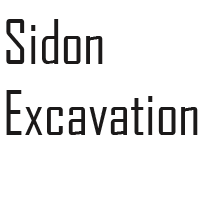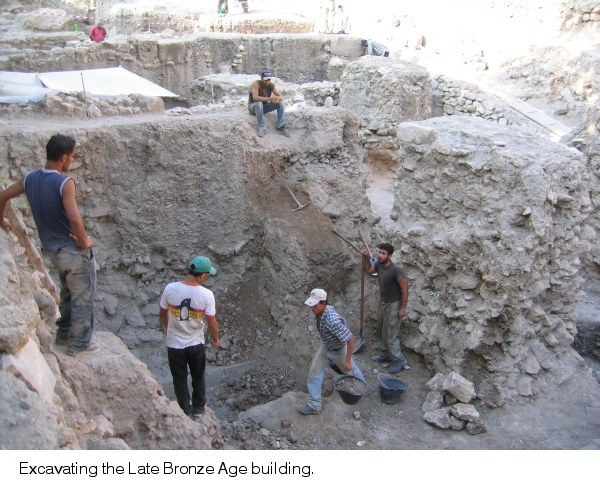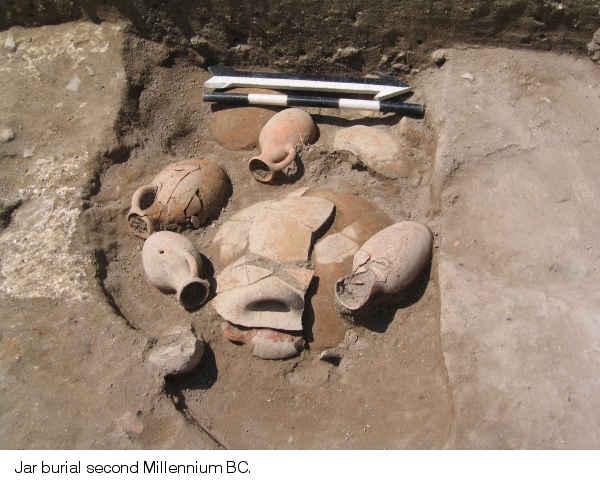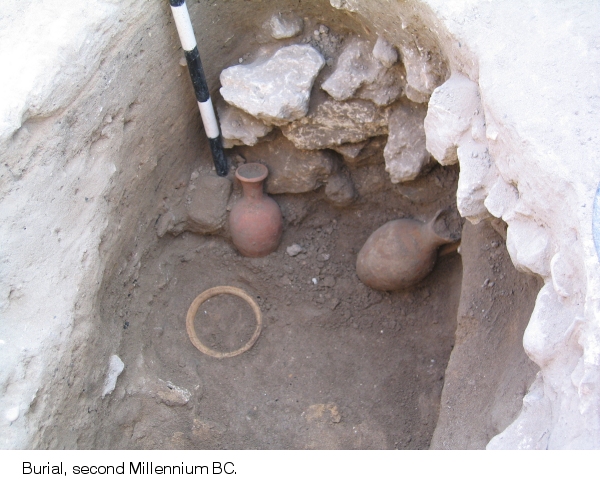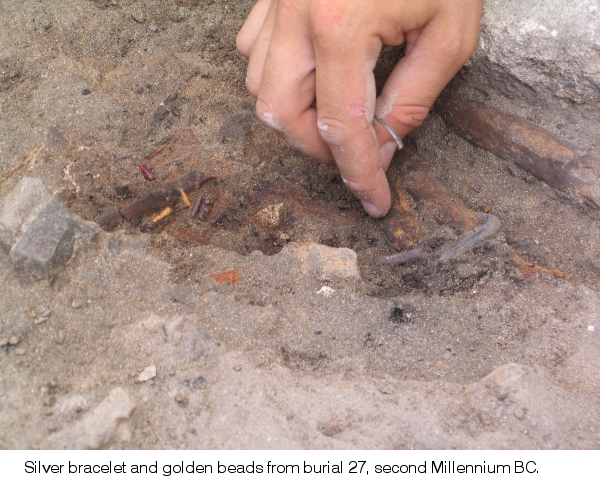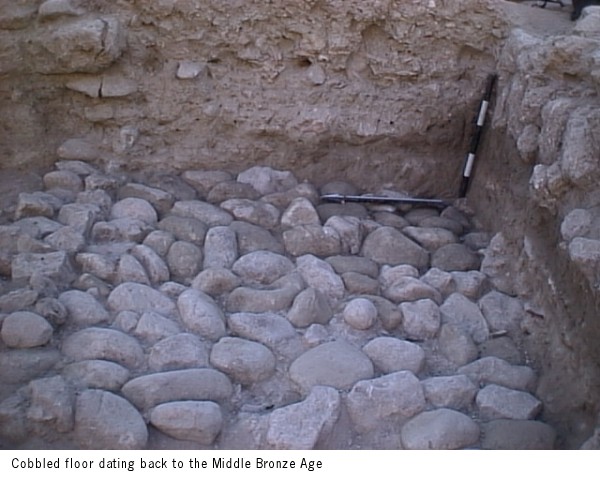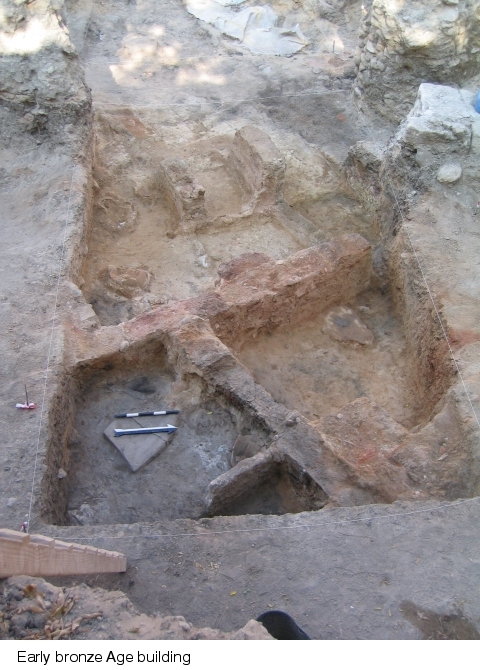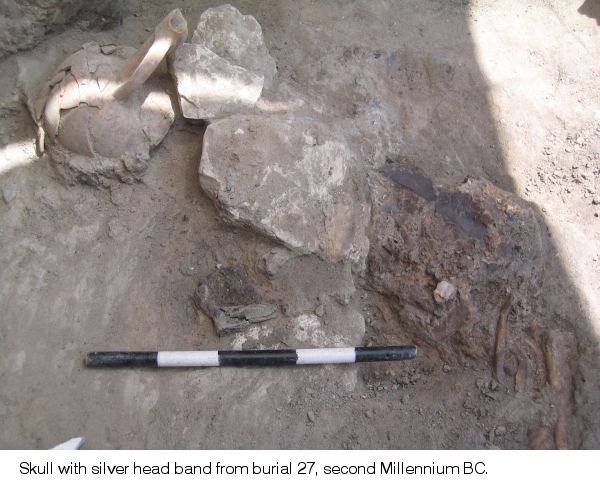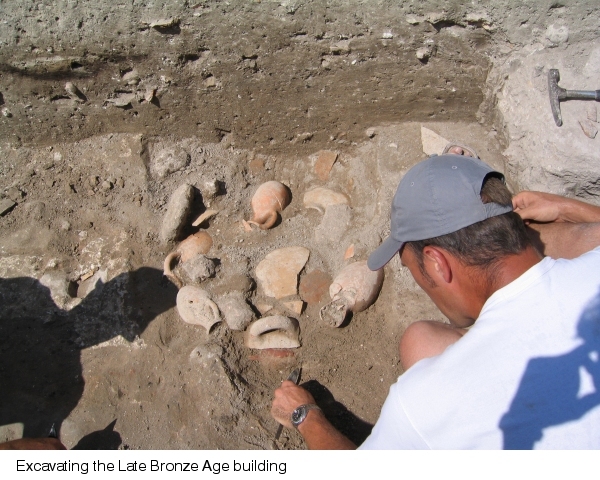YEAR 2003
In 1998, the Directorate General of Antiquities of Lebanon authorized the British Museum to begin excavations on the site of the ancient city of Sidon, 20 km south of the Lebanese capital Beirut. This was the first opportunity to systematically excavate Sidon, so well known historically and in ancient texts, but as yet unexplored because of the densly built up modern city.
Important historical facts were elucidated during the previous excavations in 1998-2002 and the fifth season during 2003 is no exception. Much new and important material has emerged about the history of Sidon and the archaeology of the Lebanon.
The Early Bronze Age
A new mud brick building consisting of seven rooms from the Early Bronze Age III was excavated. This building was destroyed in a fire, shown especially by the burnt mud brick walls and the large amount of collapsed mud brick fill. Functionally speaking the building was divided into two distinct spaces: a residential area in the south east with holemouth jars found in situ and an area in the north west of the building in which some sort of domestic activity took place. This is shown by a narrow storage space and by the traces of burning on the floor of rooms which is different from the fire that destroyed the building. Four other possible storage spaces were also found west of this building.
A further ten Middle Bronze Age burials were discovered this year. The first was the constructed grave of a warrior, who was buried with a bronze “duckbill” axe and a spearhead in addition to one pottery vessel.
What distinguished this burial is the amount of silver jewellery accompanying the deceased. He had a silver band around the head, a silver bracelet around his ankle, another silver bracelet on his right arm and a bracelet made of 5 golden beads and 4 carnelian beads on his left arm. 17 silver studs were found aligned in a circle, some on top of the axehead others on the floor of the grave as if, both studs and axe were fixed to an element that has disappeared.
A bronze ring was also found buried with two whole caprids. Another constructed grave was excavated containing just the skeleton of an adult male lying in a flexed position. No artifacts were found. One burial was dug directly on top of the sand layer.
Seven further Middle Bronze Age burials of children in jars were also found. Two of them contained Egyptian scarabs and one had a cylinder seal around the neck. These newly found burials add to the 26 from the previous seasons. Also associated with the Middle Bronze Age, and above the sand layer are a plaster and a cobbled floor as well as an assemblage with jar fragments an incense burner and a plate with marks of black heavy burning. This plate had probably been placed on the incense burner and had fallen off.
One of the main discoveries of this period has been a building of which only one underground room, a sort of basement room, remains. Later trenches followed the lines of the walls of the building, which were apparently torn down in the medieval period when the ramparts and the castle were built. Of the ancient walls themselves, only the ashlar masonry of one part of the west wall is preserved. The room measures 4.60 m x 5.70 m and is 3.70 m below the surface. The floor consists of large paving stones oriented E-W. A few narrow paving stones laid N-W were found among the large ones.
This building was destroyed by a fierce conflagration. Evidence of this conflagration is present to about 1.08 m above the level of the paving stones, which are covered in a thick layer of clay fired in the conflagration. The building had wooden beams, which were found in a good state, having been carbonized; some were found to be more than 1.05 m long. According to calibrated C-14 dating the trees from which these beams were made were grown around 1390-1120 BC.
This Late Bronze Age building provides evidence of the appearance of technical innovations that are also found in Syria in the same period. One such innovation is the use of the dovetail clamp, which is also attested in several loci at the site of Ugarit in the Late Bronze Age. The finds from the floor of the building consist mainly of very fragmentary pottery. Most of the vessels are of local undecorated wares in general use; fragments of Mycenaean wares were also found. A bone spindle whorl with incised decoration was found on the floor as was a faience scarab. The base of the scarab bears an inscription with the name of an almost unknown pharaoh, Djed-kheper-re, who reigned during the Second Intermediate Period.
The presence of four uraei, looking outwards, away from the the inscribed royal name, should also be noted. The hypothesis has been put forward that this scarab, rather than representing an obscure pharaoh, could be attributed to an Egyptian merchant, trading with Sidon at this time and simply having the same prenomen as the enigmatic pharaoh of the Second Intermediate Period. The fact that the royal name was not inscribed within a cartouche also favours this hypothesis. As things stand at present, there are still uncertainties that bear on the interpretation of this building, which we hope to continue excavating next year.
There was regular trade between itinerant Phoenician merchants and an Aegean clientele in the first millennium BC. Greek merchants also visited Phoenicia, which accounts for the many finds of Euboean pottery types. The skyphos with pendant circles, of the subprotogeometric style from Euboea or the northern Cyclades discovered this season, like the earlier Minoan cup mentioned above, is not just an object of trade, but suggests special relations in the form of gifts or offerings. This skyphos, a vessel used for eating and drinking, is one of the earliest exports of Greek pottery to the eastern Mediterranean in the first millennium BC.
In 2003 domestic installations with a series of plaster floors and a posthole have been found. Further excavations will allow us to establish a stratigraphical sequence for the 5th-4th century at Sidon.
The excavations at Sidon are of great interest for more than one reason: the archaeological complexity and richness of each stage of the development of the city is at last being revealed for the first time by benchmarks whose existence has until now only been suspected. This excavation is, after Beirut, only the second systematic urban excavation in Lebanon. The possibilities here, unlike those at Beirut, are limitless. This project is the only one of its kind in that the excavation is taking place on land expropriated by the state for the sole purpose of archaeological research. This means that part of the ancient city could be incorporated into the urban landscape at the centre of the medieval city. It would to some extent be possible in the future to see parts of Canaanite and Phoenician Sidon. The principal objective of our work, however, has been the establishment for the first time of a stratigraphical sequence and the provision of reference material dating from the beginning of the third millennium to the end of the second millennium, with some material from the first millennium BC. This sequence has a number of individual characteristics, but is distinguished by a continuous development and a gradual evolution. The locally made pottery shows the original character and the true rhythm in the development of southern Lebanon. The Minoan, Mycenaean and Euboean imports underline the importance of the sea and Mediterranean contacts to Sidon throughout its history, and provide evidence that clarifies the nature of these exchanges: their ceremonial aspect, as in the case of the Minoan cup and the Euboean skyphos, and their more commercial aspect linked to trade as in the case of the Mycenaean pottery. These are just a few of the elements that will contribute to the development of our knowledge of Sidon and that will lay the foundations for a chronological sequence for the Lebanon.
The continuation of this work will make it possible to clarify many matters relating to the typology and the dating of material found in neighbouring countries. In all, the material found at Sidon attests above all to affinities and contacts with Palestine, less frequently with Syria, but what is most important is that it is truly an intermediary between these two cultures.
One of the main objectives of the programme of excavation undertaken since 1998 was to elucidate the stratigraphy of Sidon in the third millennium BC. This objective has been attained, and the publication has been submitted. The objective now is to greatly extend the area of excavation of each level so as to reveal the plan of the ancient city and better to understand the general organization of the habitat. Continuing excavation of the Middle Bronze Age levels should lead to a refinement of the dating of the types of graves as well as to elucidate the stratigraphy of Sidon in the second millennium BC. The excavation of the Late Bronze Age building, securely dated by C-14 analysis, will be completed and the Late Bronze Age and Iron Age levels will be explored more widely.
The scientific potential of the excavations is exceptional. In short, and without any doubt, everything remains to be done at Sidon.
